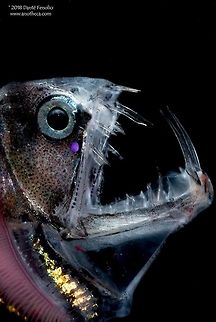
Appearance
The primary feature of interest in ''C. sloani'' is its enormous teeth. When the jaw is closed, the teeth fit together to form a cage in which prey can be trapped. Its jaw can be unhinged, allowing it to open its mouth up to 90° to catch prey up to 63% its own body size. Its teeth, however, are fixed in place, attached firmly to the jawbone rather than being depressible like in some other fish species. The immobility of its huge teeth requires it to be able to open its jaw so wide. Also helping with jaw expansion is the fact that its mouth does not have a floor.The size, shape, location, and number of teeth are consistent across individuals of ''C. sloani'', and each fang is highly specialized. ''C. sloani'' likely lures prey to its mouth with its photophore, or by arching its long dorsal ray to dangle in front of its mouth. The foremost premaxillary tooth, which is relatively straight and has sharp ridges, may then be used to wound larger prey. The curved second premaxillary tooth is thought to be used like a dagger, retaining larger prey.5 All teeth come together into a cage to retain smaller prey.Following is the original description of the species, from page 430 of Bloch and Schneider , in Latin.
CHAULIODUS: Dentes in utraque maxilla praelongi, exserti, rictus perpendicularis.
Sloani: Corpus elongatum, tenue, alepidotum viride, caput trunco latius, rictus amplus, dentes acuti discreti, apice incurvo, maxilla inferior superiorem pyxidatim claudit, oculi supremi, pinnae pectorales infimae, acuminatae, ventrales fere mediae inter pectorales et analem, dorsalis capiti, analis caudali vicina, radius primus dorsalis elongatus, setaceus. Habitat in mari Atlantico Gades alluente, sesquipedalis, latus 2 ½ pollices.
The book can be accessed in full at no cost on Google Books.
Distribution
''C. sloani'' is found in tropical and temperate waters. It is widespread in the Atlantic Ocean and the western Mediterranean Sea, as well as the Indian and Pacific oceans.In the Atlantic, its latitudinal range is from 35°N - 55°N, with highest abundance around 45°N. In the Arabian Sea, its range is primarily south of 10°N. It generally stays at depths from 200 m - 1000 m, both day and night, in contrast to ''C. danae'', whose individuals exhibit diurnal migration. Some small individuals of ''C. sloani'' also exhibit some limited diurnal migration. Larger individuals tend to live farther north.
In the central Mediterranean Sea, ''C. sloani'' is eaten as a primary part of the diet of the Atlantic bluefin tuna.
Food
''C. sloani'' is a major consumer of myctophidae, or lanternfish, having a significant effect on their population in the Arabian Sea. An average ''C. sloani'' individual probably consumes at least one lanternfish every twelve days. However, they are not picky in their diet - they also eat other fish, eggs, and algae. This is another thing that distinguishes them from the ''C. danae'', which feeds mainly on crustaceans.References:
Some text fragments are auto parsed from Wikipedia.